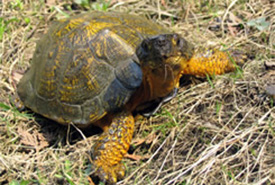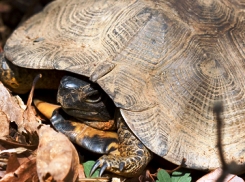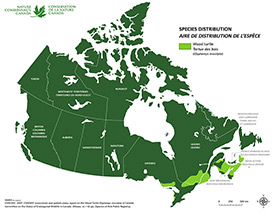
Curious wood turtle (Photo by Ryan M. Bolton)
Wood turtle
What does the wood turtle look like?
Wood turtles are medium-sized, reaching 20–24 centimetres in carapace (upper shell) length. They have a brown carapace with a distinct, wood-like texture and their plastron (lower shell) is yellow with black blotches on the outside. They have orange legs and a black head with orange flecks.
Where does the wood turtle live?
The wood turtle’s range is restricted to wooded streams and rivers in northeastern North America. In Canada, it only occurs in Ontario, Quebec, New Brunswick and Nova Scotia. It prefers streams with a moderately flowing currant and sandy or gravelly bottom. Unlike many other freshwater turtles in Canada, wood turtles are often found on land because they primarily forage for food on land. Wood turtles are known to stomp their feet on the ground, mimicking rainfall and drawing earthworms out for a meal. Their large home ranges cover several kilometres.
This semi-aquatic turtle is long-lived. In Canada it can take up to 18 years before reaching sexual maturity. This life history trait contributes to the turtle's at-risk status, since turtles may be collected or killed before reaching breeding age.

Retreating wood turtle (Photo by Bill Hubick)
What is the wood turtle's conservation status?
The wood turtle is assessed by the Committee on the Status of Endangered Wildlife in Canada as threatened. As with many species, habitat loss is the main threat to this species, and the wood turtle is also intolerant of water pollution. Current populations are small and increasingly isolated.
Because the wood turtle isn't aggressive toward humans, and because of its intelligence, it is collected from the wild to be sold in the pet trade. The removal of wild animals from natural habitat has serious repercussions for populations, especially for at-risk species like the wood turtle.
What is NCC doing to help protect the wood turtle's habitat?
In all provinces where wood turtle occurs, the Nature Conservancy of Canada (NCC) is protecting habitat for wood turtles and minimizing disturbances, such as ATV use, that could kill adults or destroy nests. There are also ongoing efforts to create suitable nest sites where wood turtles are known to occur. In Quebec, NCC also protects wood turtle habitat and works on habitat restoration projects in the Mauricie region. Because of the illegal pet trade, NCC does not communicate the location of wood turtle populations it is protecting or managing.
Want to help the wood turtle?
Education is a key component in protecting this species. As more people learn about the effects of the illegal pet trade on all wild species, demand for these animals will decrease. Never collect turtles or other animal species from the wild. If purchasing animals from a pet store, unless the vendor can certify that any animal/plant for sale was not collected from the wild then they should not be purchased. If you happen to spot a turtle in Quebec, visit carapace.ca and fill out a turtle sighting form on the website.






